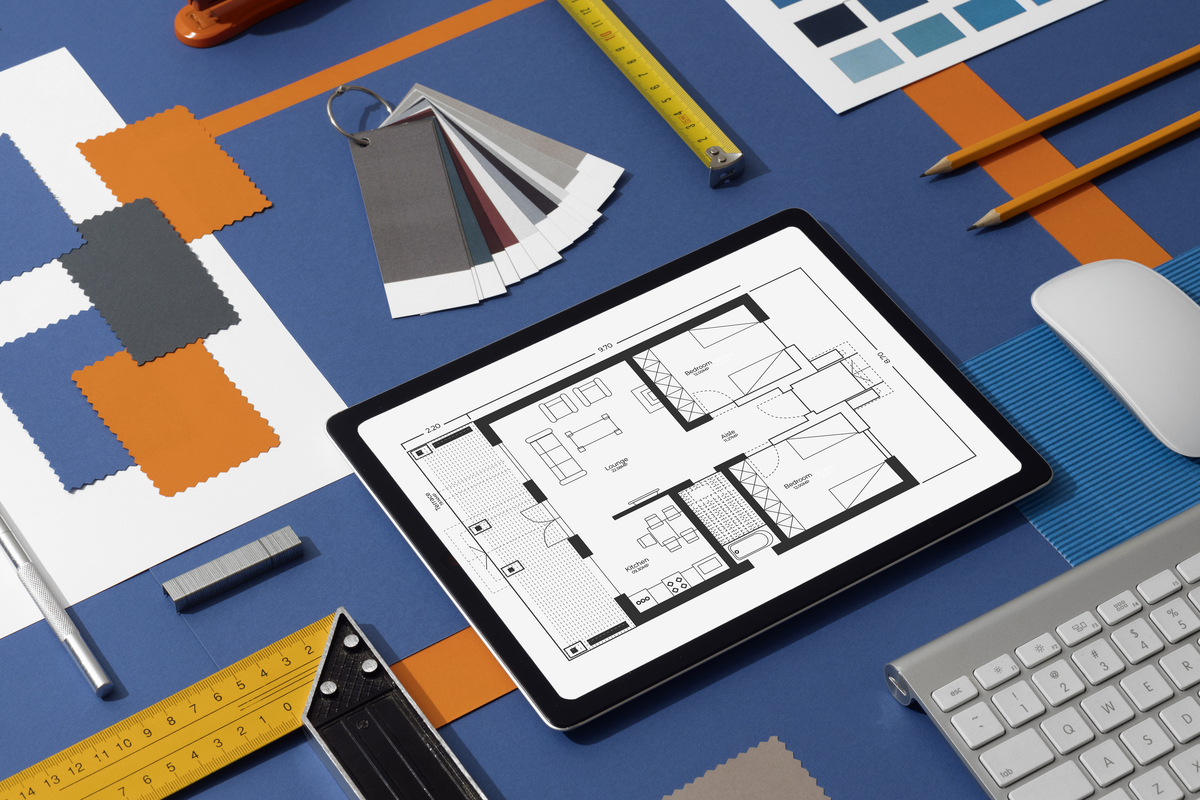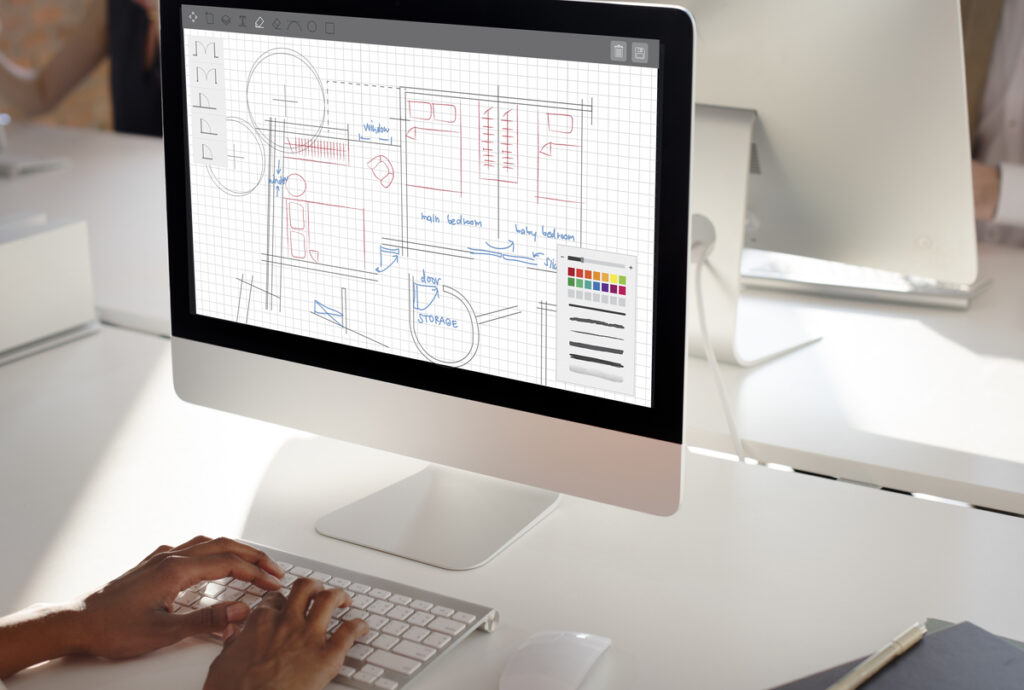Updated by Nazanin Ghodsian, 08/09/2024
Architecture has developed from paper and pencil to the sophisticated computer-aided design (CAD) world. Architectural modeling software, which provides more than just design capabilities, is currently the industry standard. To increase efficiency, optimize workflows, and foster better teamwork, it also has features for project management, flowcharting, and diagramming.
However, not every architectural modeling program is created equal. The ideal option will rely on your workflow and particular requirements. These tools can assist anyone, be they an architect, designer, or enthusiast, in producing intricate 3D models, testing out novel design ideas, and efficiently presenting their work to clients.
Moreover, architectural modeling software integrates with cutting-edge technologies such as 3D printing, enabling the creation of intricate models or complete structures. This feature not only provides a crisp preview of your drawings but also generates accurate models fast, saving you time. These tools are critical to modern architecture, whether they are used for simulation or planning.
Table of Contents
Benefits of Architectural Modeling Software
Architectural modeling software has played a significant role in the recent transformation of the field by making it easier to construct and manage larger, better, and more complex projects. The following are a few of the most well-known advantages of architectural modeling software:
- Improved drawing accuracy in comparison to conventional drawing techniques; Relatively simple creation and replication of 3D drawings;
- Overall easier data exchange and far more straightforward data usage;
- Digital drawings are far more resistant to deterioration or destruction;
- Another reason for the increase in accessibility and the simplification of the data storage procedure is digitalization.
In addition, it would be appropriate to list a few problems with architecture software as a technology. The majority of these problems are also quite hard to resolve, therefore your only option is to learn to live with them:
- Costly acquisition and upkeep expenses for the program itself;
- Many of the drawbacks of computers as a technology include their vulnerability to malware and hacker attacks, as well as more
- Common problems like hardware failures and software instability;
- Architect software might be challenging to learn and adjust to at first.
CAD architectural modeling software has proven to be of great assistance to architects worldwide, providing numerous advantages to its users. These include enhanced communication, improved teamwork among architects and other project participants, faster and more effective drawing overall, and superior client presentation of the future results.
Suggested article to read: Top 7 Construction Project Management Software Solutions for 2024 |13 Best Architectural Rendering Software; 2024 Review

11 Best Architectural Modeling Software
Here is a list of the 11 best architectural modeling software worth knowing about:
1. AutoCAD, Best Architectural Modeling Software for Professionals
Because developer Autodesk included specialized building design and architecture toolkits, AutoCAD has long been a mainstay for construction engineers and architects. This is among the top architecture modeling software tools available; it’s not simply another computer-aided design (CAD) product.
Architects should expect increased efficiency while using this architectural modeling software. With the integration of automatic object production and pre-built items, the application expedites the design process. This facilitates the rapid placement of systems for generating sections, elevations, and plans from model geometry, as well as walls, doors, and windows.
Numerous other architectural modeling software can also work with regular AutoCAD files; however, if you have the appropriate tools, you may easily convert AutoCAD to PDF and PDF to AutoCAD.
But there’s a big catch. Most people in the building design industry still use AutoCAD as a 2D architecture tool, but more and more are turning to real BIM applications. Autodesk offers Revit to customers who are interested in BIM.
Reasons to Buy
- Comprehensive toolkit
- Efficient keyboard shortcuts
- Autodesk integration
- Built for professionals
Reasons to Avoid
- Steep learning curve
- Not BIM-orientated
2. Chief Architect Home Designer Architectural, Best Architecture Software for Exterior and Interior Design
If you are more interested in residential than commercial structures, this architectural modeling software is a fantastic option. Chief Architect is a professional-grade architectural modeling software that is ideal for architects, remodelers, and interior designers alike. It is one of the greatest tools for creating homes both internally and externally. With a wide selection of tools to help you start your project, the software offers 2D and 3D drawings, floor plans, 3D renderings, and construction drawings.
Professionals who work in home design have access to two versions of this architectural modeling software: “Interiors” for those who work inside the house and “Premier” for detailed exterior and interior design.
Therefore, helpful for people with more specialized needs (who desire a strong professional instrument to accomplish particular goals). With either version, you can quickly create 3D models of both interior and exterior spaces, which you can then project into 2D plans and elevations. You can either buy Chief Architect completely or subscribe every month.
Reasons to Buy
- Easy to use
- Powerful smart features
- On Windows and Mac
Reasons to Avoid
- Better for residential over commercial properties
- 3D views can sometimes display incorrectly
Suggested article to read: Top 5 Construction Waste Management Software Solutions for 2024 | 10 Best Construction AI Software in 2024
3. 3ds Max, Best Architecture Software for 3D Modeling
Another product from Autodesk is 3ds Max, which is among the greatest architectural modeling software, particularly for architects who want to create photorealistic open spaces.
One of the first tools for hardware-accelerated 3D picture rendering was the creative tool. Nowadays, this architectural modeling software’s greatest use is for producing beautiful images and fly-through animations, which makes it one of the top architectural rendering software packages for project promotion. It also has a ton of automation options to help maintain the design process’s momentum.
You can select from three “Industry Collections” to fit your needs in addition to the basic 3ds Max subscription package: Product Design, Media & Entertainment, Architecture, Engineering, and Construction.
Top architect software, including AutoCAD, Civil 3D, and Revit, is bundled in this final package. In addition, it contains tools for vehicle path calculations, steel details, building performance analysis, and structural analysis. But unlike AutoCAD, 3ds Max isn’t supported on Mac computers. The learning curve for that degree of control and capabilities is higher than for other architecture software on the list. Once learned, however, it’s the perfect software for architects creating detailed 3D settings.
Reasons to Buy
- 3D modeling and animation
- AutoCAD file support
- Powerful Plugins
Reasons to Avoid
- A steep learning curve
- Premium pricing
- No Mac support
4. SketchUp Pro, Best Architectural Modeling Software for CAD Beginners
SketchUp is a terrific place to start if you’re new to 3D modeling because it’s as simple as CAD gets. Originally, this architectural modeling software was a Google-backed initiative. Even if ownership has changed since then, the clear, user-friendly interface that characterizes the Google product suite is still there.
Designers should be able to use it quickly to create intricate solid geometry after following a few basic instructions. While it may not be the best option for fully designing a building, it is a great tool for quickly developing a notion when it is still in the conceptual stage.
However, the fact that this architectural modeling software offers free 3D architecture software is what sets it apart. Naturally, it is restricted, but it allows experts to test the product before deciding to purchase a commercial license.
SketchUp is one of the top architecture software programs because of its free building design offer, which has also created a huge and active user community that is willing to assist novice users. An enormous user-generated object library, a vast repository of pre-constructed elements to plug into any project, is another example of this community spirit in action.
Reasons to Buy
- Free version for home use
- Very easy to learn
- Good for beginners
Reasons to Avoid
- No built-in rendering
- Not a collaborative tool
Suggested article to read: Top 7 Construction Workforce Management Software Solutions for 2024 | Best Construction Management Software in 2024
5. Civil 3D, Best Architectural Modeling Software for Civil Engineers
Another excellent architectural modeling software from Autodesk’s toolset, Civil 3D, does more than just the modeling and drawing CAD functions that the majority of architects and builders use.
Civil 3D adds a twist to the platform by enabling the creation of 3D model-based environments and designs. To maintain collaborative projects on schedule, the technology also provides a simplified, design-driven documentation pipeline for those who work with BIM workflows.
This architectural modeling software for civil engineering is intended to be used with other Autodesk products, specifically AutoCAD, Revit, and 3DS Max. Because of this, it ranks among the top architecture software packages for experts within the Autodesk ecosystem.
The integration of survey photos with highways, service schematics, constructional geometry, and terrain modeling is one useful capability. These components are gathered into one comprehensively annotated package. This enables experts to examine the potential effects of design modifications on various areas while concentrating on a particular one.
Reasons to Buy
- Command-line interface
- Versatile approach
Reasons to Avoid
- Occasional stability issues
- The cloud isn’t well-supported
- No Mac version
6. CATIA, Best Architectural Modeling Software for Precision Modeling
Originally, CATIA was developed as a precision modeling tool for military gear. And for that, it is more than competent in creating intricately detailed models and managing demanding architectural requirements. As a bit of a trailblazer, the program has been around for thirty years now. Although many architecture software packages have since included security-controlled distribution and collaboration features, CATIA was the first to offer these features.
It also keeps up with the changes, with performance-boosting updates that add to the coordinating elements already in place and incorporate cloud functions. The user interface of the program is aesthetically beautiful. If you are familiar with other architectural modeling software, you should have no trouble getting started with CATIA, even though it has a steeper learning curve than other programs (this is a trade-off for military-grade accuracy modeling).
There is no set cost for this robust, feature-rich architectural modeling software. Rather, your company will have to ask for a quote based on your requirements and usage.
Reasons to Buy
- Huge model complexity
- Very precise model data
- Easy to learn
Reasons to Avoid
- Premium pricing plan
- May overwhelm non-designers
Suggested article to read: Top 11 Energy Analysis Software in Construction (2024)
7. Revit, Best Architecture Software for BIM Designers
This architectural modeling software is the business’s BIM-focused product, which is another Autodesk architectural modeling software. This is among the greatest architect software packages accessible if you enjoy AutoCAD but require BIM capabilities.
It is not just useful for architecture in the industry. The 3D architectural software, which facilitates building design, architectural modeling software, coordination, and collaboration features while the team is working on the same scheme, will also help structural, MEP, and construction professionals.
When utilizing Revit, designers deal with objects rather than a vector connecting two points. This implies that they have confidence and can work fast. Additionally, paperwork can be reduced to facilitate BIM operations, much like in Autodesk’s Civil 3D.
But if you’re switching from AutoCAD to Revit, you might initially find the change a little intimidating. However, the architectural software offers a significant competitive advantage over conventional design applications once you’ve climbed the steeper learning curve.
Reasons to Buy
- Highly efficient tool
- Smart object connectivity
- Built for BIM
Reasons to Avoid
- Little overlap in AutoCAD commands
- May overwhelm newcomers

8. Rhino, Best Software for Architects Working with Curves
Rhino is an effective architectural modeling software for modeling curved surfaces and smoothing the appearance of buildings. Rhino was created from the ground up to handle curved lines, meshes, and highly complex NURBS surfaces, such as those found in the sweeping curves of a supercar or the contours of a human face. Most CAD systems excel at rectilineal architecture.
This architectural modeling software is a useful tool for modeling intricate intersections found in curved roofing and other non-linear structural elements in architectural design. It is not a particular tool; it is a platform. Instead, it customizes the application for individual users and jobs via add-ons, such as the BIM capability add-on, and the Grasshopper visual programming system.
Because of this, Rhino is an incredibly versatile tool that can be adjusted to automate intricate modeling and detailing processes for projects that require them. This architectural modeling software has a one-time fee, which is fantastic if you don’t want to pay a membership fee and don’t mind paying a one-time fee. Like it used to be, the software is yours forever because licenses are perpetual and never expire. Unusually for CAD architectural software, upgrades typically cost half as much as a new license and you are not required to upgrade to the following iteration.
Reasons to Buy
- Very powerful modeler
- Plugins and scripting
- Third-party services
- Subscription-free with good upgrade options for existing users
Reasons to Avoid
- BIM functionality is an add-on
- Not technically a specialized tool
Suggested article to read: Top 7 Digital Twin Software in 2024
9. Archicad, Best Home Architectural Modeling Software
Although Graphisoft’s Archicad isn’t just for tiny buildings, we challenge you to find a more feature-rich pure architectural modeling software on our list than this one. For someone who makes a living in architecture, it’s an excellent option with strong project management and design capabilities. Archicad is easy to replicate for residential architecture designs because of its versatility with small projects (a clear, uncomplicated interface and smooth project management features).
Although users appeared to encounter more difficulties throughout the technical development phase compared to the earlier stages, 2D drawing was very easy to use. Tools for animation that work well to bring your renderings to life so you may effectively present your architectural concepts.
These powerful BIM modeling tools also enable you to show how a structure will appear from the outside and the interior. Strong project management capabilities were cited by users in the user evaluations we examined as one of this architectural modeling software’s best features. The program is intended for companies that manage a large number of architectural projects.
Reasons to Buy
- Robust project management features
- Doesn’t require expensive CPU
- Easy to integrate multiple users
Reasons to Avoid
- Requires GDL programming knowledge
- Buy and pay pricing structure
10. Blender, Best Free Architectural Modeling Software
Free. The word simply sounds good, isn’t that right? But Blender isn’t simply attractive because it’s free; it’s also a remarkably reliable and feature-rich choice. Although it may not be the full architectural solution a corporation needs, this open-source rendering software is a great place to start at a reasonable cost.
It works best, in our opinion, when showcasing renderings in an agency setting—for example, when showcasing plans to prospective clients. You won’t be using it for sharing on your phone; instead, you’ll use it at the office or on a PC due to its lack of mobile functionality. Because Blender is free, there is a thriving online community that makes it simple to locate information for using Blender.
People adore Blender’s 3D modeling features, which include simple-to-import graphic components that provide a personalized touch to your work. Although there is a high learning curve, you have plenty of time to get used to it as it is free. Make your drawings come to life by adding details like flickering flames and wind-blown grass.
Blender animation excels in lighting, which many users thought brought scenes to life beyond simple use as “Free architecture software.” While there is plenty of 3D modeling and animation to keep you busy, there are also a lot of 2D elements, which are perfect for making quick sketches and designing blueprints.
Reasons to Buy
- Robust design features
- Frequent updates from an active community
- Easy to import visual “Objects”
Reasons to Avoid
- Lack of project management features
- Steep learning curve
Suggested article to read: Best Construction Management Software in 2024
11. LibreCAD, Easy to Use and Powerful
LibreCAD is an excellent CAD program that is easy to use and powerful for 2D modeling. In comparison to the other options on our list, it cannot be considered clever software, but even so, it is a great tool to have on hand when money is tight.
You can quickly become accustomed to it because of its simple, AutoCAD-inspired interface and create accurate floor plans, elevations, and sections with ease. When designs become sophisticated, LibreCAD also includes extra tools that let you arrange your drawings into layers, blocks, and characteristics.
Reasons to Buy
- LibreCAD is free to use, with no hidden fees or limitations
- Available in over 30 languages
- Runs on MacOS, Linux, and Windows
Reasons to Avoid
- Supports only 2D design
- Limited features, especially for architectural design
How to Choose the Best Architectural Modelling Software?
Because there is a large market for this kind of software and it can be challenging to foresee the features you will need in your future job as an architect, choosing the right software can be a challenging task. Selecting software on your own is frequently regarded as one of an architect’s initial significant choices.
However, it’s crucial to avoid being seduced by software that has the highest number of reviews or a generally positive rating because it can not have all the capabilities you require for your job or it might simply be an extremely expensive option that you cannot afford to keep up with payments for.
When selecting a particular architectural solution for yourself, there are several things to keep in mind. To help you make your decision, you should ask yourself two or more questions about each of these variables. We have seven different factors in the list below:
1. Industry Standards
Naturally, the software that other professionals in the same sector use is one of the most important determining elements. This section also covers what is popular with big businesses, what software is in great demand right now, and what is popular in your area or where you are studying.
A noteworthy aspect that requires clarification in this context is the extent of assistance and justification offered for a specific resolution. It is not uncommon to find a highly popular product with little to no instructional resources available, so prospective customers should do their homework before committing to anything.
Suggested article to read: 10 Best Construction Accounting Software Programs in 2024
2. Personal Preference
Your prior software-related experiences can also play a significant role in your decision-making process, particularly if you have previously identified a program that you feel at ease using. The same remark also applies differently; perhaps some features or design decisions in your present solution are things you would prefer not to see in an architecture program.
Determine what the organization needs the software for before investing in architectural software (or any other enterprise-level software, for that matter). You would be left with no purpose for the solution’s general abundance of capabilities if it wasn’t appropriate for your particular use case. The following questions might be useful in determining what you would require from an architectural solution:
- With this software, what issue are you trying to solve? Do you currently have a solution in use for this same purpose? What particular issues does such a solution have?
- To what extent does this work require cooperation? Is regular communication with other team members required, or is it voluntary?
- What is your line of work or profession? Which branch of the architectural profession do you work in? Do you operate as an individual or as a team?
3. Difficulty in Working with the Software
Even while some software is very easy to learn, it is typical for the architectural software business to have rather complicated software that is challenging to master from the ground up. For novices, software like SketchUp can be rather basic and offer sufficient knowledge to prepare them for some of the more advanced architectural platforms.
It’s crucial to keep in mind that simplicity does not equate to worse quality; this is true across many industries, including the architecture software sector. To avoid any further annoyances with your future software due to it being too hard for you to work with, it is helpful to have a clear grasp of your abilities with architecture software before selecting the program in issue.

4. Your Current Hardware
Another characteristic shared by all architecture computer programs is their need for powerful hardware. Before buying the software, it is strongly advised to familiarize yourself with its suggested specifications, as many architectural applications tend to be very demanding in this regard.
This is also the point at which you could have to make a crucial decision between cloud-based software and on-site applications. The former is largely reliant on the performance of your existing gear, but it is typically more feature-rich and adaptable. The latter is frequently less feature-rich but makes up for it by being less expensive initially and more adaptable (no need to buy pricey hardware).
Another issue is “Perpetual licenses,” which frequently force customers to buy a subscription to access customer service and receive regular feature updates. This specific strategy is by no means user-friendly, but there are still many options that are, particularly in the case of enterprise-level software.
Suggested article to read: 15 Best Project Management Software of 2024
5. The Software’s Capabilities
The market for architectural modeling software as a whole is very big, with a wide variety of features, software versions, and other aspects. It can serve as a tool primarily for concept creation, or it can be used for actual design work. It also has presentation features and the capacity to render real objects, among other things. Before making any real software purchases, this subject needs to be carefully investigated. These factors are only a few of the numerous facets that architectural software can have.
Organizing all the characteristics you require in an architectural modeling software into two categories—”Nice to have” and “Must have”—is a smart technique to tackle this specific subject. In this manner, you would be much better able to determine what particular characteristics you need to search for and what is not strictly required for day-to-day work and is not worth the investment. Examining the characteristics that your present architectural modeling software offers could also help you find some of the functionality you want.
6. The Price of the Architectural Modeling Software
Although there are both paid and free solutions in this specific market for architectural modeling software, it’s vital to keep in mind that paid products are not always superior to free ones. Furthermore, the quality or versatility of architectural software is not necessarily directly correlated with its price. Numerous solutions also provide a kind of tiered pricing, with some capabilities hidden behind a paywall that is more expensive than the basic bundle. Therefore, doing extensive research on the subject is strongly advised.
7. What this Particular Software is Compatible with
Compatibility should be one of the primary determining elements for any architect, given the size of the market. It is rare for architects to operate alone; instead, many projects require cooperation between many architects and other industry experts.
Compatibility is therefore crucial when selecting architectural modeling software for yourself, as incompatible software will negatively impact the efficiency of the project as a whole. For this reason, we have included a thorough description of each software’s features along with our extensive list of the top architectural computer programs.
Conclusion
Even though architecture is a very old profession, written and drawn documentation has always dominated the field. Thankfully, the pen-and-paper technique of work was superseded by technological advancement, since all architecture-related documentation may now be prepared and edited online.
Architectural development is a rather complex process that involves many different modeling stages, hence there are a ton of software solutions for it on the market that serve various functions and objectives. As a result, many find it difficult to make the right choice. It can be difficult to choose the right architecture software from the extensive online directory. To make things easier, we’ve chosen the best applications and created a helpful guide to help you make decisions.
Working as an architect requires having a solid understanding of architectural modeling software, which is used to produce virtual representations of designs that clients may view to see how they might look in real life. They can produce intricate 3D models and incorporate outside factors like daylight. It’s a good idea to become familiar with the top architectural modeling software if you’re interested in a career in architecture.
FAQs
What is Architectural Modeling Software?
- Answer: Using digital tools, architects and designers may produce intricate three-dimensional models of buildings and structures: architectural modeling software. It facilitates project planning, simulates construction procedures, and helps envision designs.
How does Architectural Modeling Software Benefit Architects?
- Answer: Accurate 3D modeling, early detection of design flaws, enhanced stakeholder participation, and overall process efficiency are all made possible by it for architects.
What are the Key Features to Look for in Architectural Modeling Software?
- Answer: Compatibility with other design software, parametric design, BIM integration, 3D modeling, rendering, and collaboration tools are among the key features.
Suggested articles for reading:
Top 5 Construction Document Control Software Solutions in 2024: A Comparative Review
Top 21 Architecture Firms in the World; 2024 Review
Artificial Intelligence or AI in Architecture; Guide to 2024
The 18 Best AI Architecture Generators of 2024
The Role of Architecture in the Metaverse; Comprehensive Guide 2024
Resources:
TechRadar | Autodesk | B2Breviews | Revizto | Sculpteo | SourceForge | Gartner | Monograph | Goodfirms
For all the pictures: Freepik





